|
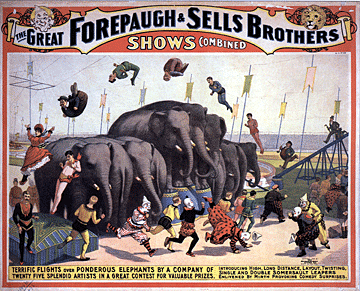 "LADEEZ
AND GENTLEMEN, CHILDREN OF ALL AGES! WELCOME TO THE GREATEST SHOW ON EARTH.,"
shouts the ringmaster of the Ringling Brothers Barnum & Bailey Circus as
the performers and animals march into the tent in the grand parade. America’s
love affair with the circus, lasting over 200 years, has survived the
minstrel show, the medicine show, and vaudeville. "LADEEZ
AND GENTLEMEN, CHILDREN OF ALL AGES! WELCOME TO THE GREATEST SHOW ON EARTH.,"
shouts the ringmaster of the Ringling Brothers Barnum & Bailey Circus as
the performers and animals march into the tent in the grand parade. America’s
love affair with the circus, lasting over 200 years, has survived the
minstrel show, the medicine show, and vaudeville.
Weeks ahead of the show, an air of anticipation came to
towns across America as advance men, wielding buckets of paste and
long-handled brushes, pasted huge, bright circus posters over faded auction
and political signs and placed cards in store windows within a 50-mile
radius of the circus site. Boys and girls stood before them and gawked, as
they inhaled the pungent smell of fresh paste.
What better way to relive the nostalgia of those bygone
shows than to collect bright, and often artistic, circus posters. Circuses
played on the fantasies of the common man. Posters advertised stupendous
acts with words like electrifying, d’equitation, noble,
liliputian, amazon, bravest, world famous, and exotic.
They promised showgoers snarling lions from darkest Africa and elephants
from the exotic East, along with aerialists performing daring acts high in
the air and lady equestrians in glittering tights. P.T. Barnum, always the
master showman, knew that the circus brought joy into the humdrum, and often
sad lives of its patrons. And circus posters reflected that in their bright,
colorful illustrations and myriad of type styles. Today, these same posters
are highly collectible.
Early
Circus History
Circuses, as they’re known today, began as
equestrian exhibitions, which later added tumbling, rope-dancing and
juggling. John Bill Rickets, a first-class trick rider from Britain, gave
the first circus performance in 1793 at The Riding School in Philadelphia.
 After the War of 1812, circus owners replaced the
permanent equestrian type shows with rolling shows that pitched their tents
on village greens. These became the direct descendants of the tented
circuses of today. The first to put on a traveling show was Hackaliah
Bailey, who, in 1815, purchased Old Bet, an African elephant, from a sea
captain for $1,000. Bailey had such success in presenting Old Bet to the
local townspeople and farmers, he arranged to purchase additional exotic
animals from other ship captains. After the War of 1812, circus owners replaced the
permanent equestrian type shows with rolling shows that pitched their tents
on village greens. These became the direct descendants of the tented
circuses of today. The first to put on a traveling show was Hackaliah
Bailey, who, in 1815, purchased Old Bet, an African elephant, from a sea
captain for $1,000. Bailey had such success in presenting Old Bet to the
local townspeople and farmers, he arranged to purchase additional exotic
animals from other ship captains.
America
grew and changed as did the circus. In 1884, five brothers from Baraboo,
Wisconsin--Al, Alf, Charles, John, and Otto Ringling–who not only had a
flair for showmanship but were superb businessmen, started a circus. When
they took over the Barnum and Bailey Circus in 1908, they could stake a
legitimate claim to the title "Greatest Show on Earth." Since 1919
the Ringling Bros. and Barnum & Bailey Circus, also known as "The
Big One," has traversed the country.
The American circus has left a legacy of collectibles–sequin-bedecked
acrobatic costumes, floppy clown hats, and paper items of all kinds. But it’s
the latter, especially posters, that have become the hottest items sought by
collectors. Referred to as bills, slang for "handbills," they
became an important element in the success of any circus early on.
Circus
Advertising
Advertising a circus was a challenge before
radio, T.V. and the Internet. To be successful, a circus owner had to market
his show–which often ran for only a day–from scratch just about every
week. To stay ahead of the competition from competing shows, an owner had to
create a brand name (his circus’ title) that would be so recognizable as
to generate repeat patrons for his circus. In addition, he had to advertise
the features of his show to set it apart from others. And, finally, he had
to display the date of the show prominently so patrons could plan to attend.
Poster
Production
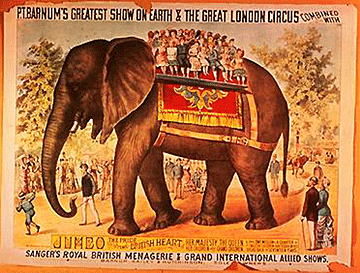 To create poster illustrations, early 19th-century
printers used mahogany wood blocks for wood engravings and pine blocks for
cruder woodcuts. Because the mahogany blocks were expensive and the
engravings hard to make, printers used them over and over again for
different show posters. Many early posters, printed on bright white, medium-
weight rag paper with oil-based inks, included the name of the show, with a
date added later by the circus’ advance crew. To create poster illustrations, early 19th-century
printers used mahogany wood blocks for wood engravings and pine blocks for
cruder woodcuts. Because the mahogany blocks were expensive and the
engravings hard to make, printers used them over and over again for
different show posters. Many early posters, printed on bright white, medium-
weight rag paper with oil-based inks, included the name of the show, with a
date added later by the circus’ advance crew.
The invention of the lithographic printing process in the
1798 by Aloys Senefelder, a German map inspector, drastically changed poster
production. Using this process,, which depends on the mutual repulsion of
water and grease, printers applied a design using a greasy crayon or liquid
onto a 28 x 42-inch block of limestone. Then onto the wet stone they would
roll oil-based ink, which would adhere to the greasy drawing or painting,
and run it through a press to transfer the image onto dampened paper. Though
sparingly used for almost 50 years after it appeared, it had become an
indispensable tool for printers by the 1880s.
Printers enlisted the services of the finest artists to
design circus posters. However, few signed their work. While some
specialized in particular subjects, most worked in teams to create the
posters in a more or less assembly line process. Therefore, posters became
known by the companies that printed them and not by the artists who created
them.
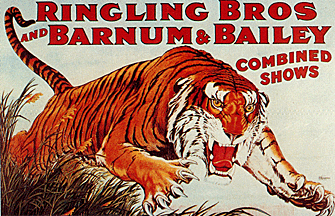 "Probably the greatest image ever produced as a
circus poster design was that of a leaping tiger, designed by the noted
illustrator Charles Livingston Bull in 1914," said Neil C. Cockerline,
circus historian. "This particular image may well be the most
recognizable circus image in history, and it is still utilized today, often
appearing in set and costume designs in current productions of the Ringling
Bros. and Barnum & Bailey Circus." "Probably the greatest image ever produced as a
circus poster design was that of a leaping tiger, designed by the noted
illustrator Charles Livingston Bull in 1914," said Neil C. Cockerline,
circus historian. "This particular image may well be the most
recognizable circus image in history, and it is still utilized today, often
appearing in set and costume designs in current productions of the Ringling
Bros. and Barnum & Bailey Circus."
Printers
offered stock poster designs featuring acrobats, clowns, elephants and other
wild animals to which they added the show title and date. Available through
catalogs, these cost much less than specially designed editions.
"It was not uncommon for more than one circus to use
the same poster designs in the same season, the only difference being the
show title on the posters," added Cockerline. "Printed stock
posters might remain in storage for years until they were sold to a circus
to be used. It is not uncommon to find posters used during a specific year
which had actually been printed decades before."
Printers based a poster’s dimensions on the size of the
printing bed. After the introduction of lithography, the size of a litho
stone, called a sheet, became the standard. So printers identified posters
in units of sheets or half-sheets. Horizontal posters became known as flats
and verticals, uprights. Larger posters came in multiple sheet sizes from 2
to 24. The combination of sheets determined the type of poster produced.
Identifying
and Dating Circus Posters
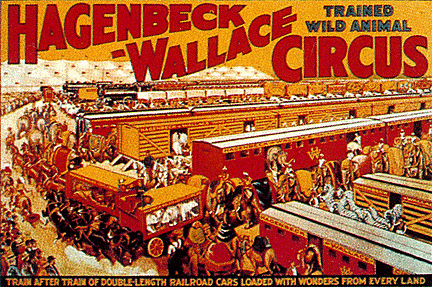 Circus posters can be identified by their
creases since all needed to be folded for storage and shipment, and each
show printer folded his posters in a slightly different way. But they can
also be dated by looking for date sheets–smaller papers pasted onto
posters indicating the day and date of the show and only good for one day
and town–as well as date tags, small strips pasted along the bottoms of
pictorial one and half-sheet posters by advance billing crews. These can
help a collector identify the year a circus used a poster since shows kept
yearly records of their routes, which are now housed in museums such as the
Hertzberg Circus Museum in San Antonio, Texas. Circus posters can be identified by their
creases since all needed to be folded for storage and shipment, and each
show printer folded his posters in a slightly different way. But they can
also be dated by looking for date sheets–smaller papers pasted onto
posters indicating the day and date of the show and only good for one day
and town–as well as date tags, small strips pasted along the bottoms of
pictorial one and half-sheet posters by advance billing crews. These can
help a collector identify the year a circus used a poster since shows kept
yearly records of their routes, which are now housed in museums such as the
Hertzberg Circus Museum in San Antonio, Texas.
According to Cockerline, when billposters and
lithographers became unionized by the 1950s, any poster put up got a
Billposter's Union Stamp, which is another way of dating a poster.
Different
Posters for Different Purposes
Circuses used a variety of posters to
advertise their shows. Printers created half-sheet and full-sheet panels
featuring horizontal or vertical illustrations especially to fill narrow
spaces in store windows, to allow advertising without covering too much of
the window display. One-sheet panels measured 21"x 54". Half-sheet
panels, printed with either vertical or horizontal designs, measured
14"x 42." Guttersnipe referred to circus paper several feet
wide by only a few inches high that was intended to go on rain gutters over
store fronts; and "banners," for outdoor displays, were usually
mounted on thin stiff cloth.
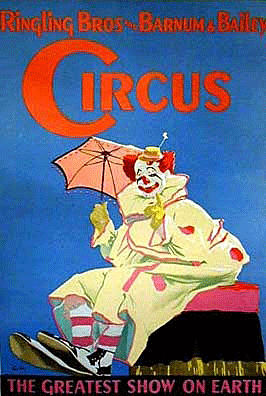 Small
one-color-on-white date sheets, printed using the letterpress printing
process, displayed the circus’ name, date and location of the show.
Advance men plastered these all over a town several weeks before a circus
was to arrive. Thus, circuses were the first to use saturation advertising. Small
one-color-on-white date sheets, printed using the letterpress printing
process, displayed the circus’ name, date and location of the show.
Advance men plastered these all over a town several weeks before a circus
was to arrive. Thus, circuses were the first to use saturation advertising.
Window cards or placards, consisting of an image printed
on a facing sheet backed with cardboard, were another form of poster,
usually in quarter-sheet dimensions or less often in odd-sized dimensions
between a quarter- and half-sheet size.
In the mid-1970's, Ringling Brothers and Barnum &
Bailey adopted a policy of using only a single poster design for each
edition of their circus, often incorporating a variety of featured acts or
attractions in the design. The poster designs also incorporated large blank
spaces allowing for localized information to be printed in as needed, thus
eliminating the need for date tags and date sheets. By the late 1970's, few
circuses even used posters, and many shows opted to use window cards only,
which could be placed indoors or simply be stapled to telephone poles
outside.
According to circus aficionados, the finest printer of
circus posters was Strobridge & Company of Cincinnati. Today, Strobridge
posters are the most popular with collectors.
Circus
Poster Reproductions
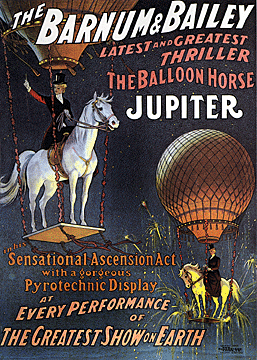 Any printed design can at some time be
reproduced. "In any collectible market that warrants high prices for
items, you’ll always run into people reprinting originals," said Brad
Hopper of Track16vintage.com, of Santa Monica, CA. "In some cases it
hurts the market, especially when people don't care that it’s original,
but in most cases, it just shows that Any printed design can at some time be
reproduced. "In any collectible market that warrants high prices for
items, you’ll always run into people reprinting originals," said Brad
Hopper of Track16vintage.com, of Santa Monica, CA. "In some cases it
hurts the market, especially when people don't care that it’s original,
but in most cases, it just shows that
there’s a high demand for the originals. Serious
collectors must have the original or they don't collect the item at
all."
According to Alan Wigton, owner of Little Journeys
Bookshop of Mansfield, Ohio, there are many circus poster reproductions,
usually of smaller sizes done for resale at circus shows. "Most circus
posters sold on eBay are these, " he said. "Outright fakes are
perhaps less of a problem than with other collecting areas. But collectors
have to learn the reproductions if they’re interested in the more exotic
older images."
Wigton added that the broad range of post-war posters are
a bit tougher to sell than some of the other circus ephemera from the period
such as programs, route books, etc. "Prices are pretty affordable as a
result," he said. "Prices of pre-World War I and late 19th century
posters are a different story. They’re scarce, of course, with a few deep
pocket collectors ready to pay for the best ones. In all areas there’s a
certain amount of market for circus posters as decoration, without respect
to collecting, per se."
Wigton noted that most collectors of circus material go
for a few posters to augment a collection, but they find it tough to display
more than a few and aren't as avid about them.
The
Market for Circus Posters
"One interesting thing I found...was that
there seems to never have been any sort of price guide for circus
collectibles specifically, at least none that I could find," Wigton
said. "People who like circuses are beer and hot dog types. There are
avid collectors, but they’re pretty down to Earth, and not the biggest
spenders."
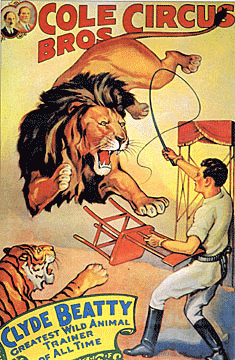 Generally speaking, circus posters can sell anywhere from
$30 to $375. With such a broad range, collectors must take the specific
circus, date, and condition into consideration. At the low end might be a
mint (never hung) Famous Cole 3 Ring Circus poster with black type on
44" x 28" yellow stock, with show name and motto in type as much
as 10 inches high for $30. At the high end might be a rare Cole Bros. Circus
22½" x 42½" poster from the Erie Litho. & Ptg Co., Erie PA.,
with the title, "Cole Bros. Circus Presents Quarter- Million Pound Act
of Performing Elephants–The Most Colossal Train Animals Display Ever
Presented" for $375 (Antique Carta, Richardson, TX) Generally speaking, circus posters can sell anywhere from
$30 to $375. With such a broad range, collectors must take the specific
circus, date, and condition into consideration. At the low end might be a
mint (never hung) Famous Cole 3 Ring Circus poster with black type on
44" x 28" yellow stock, with show name and motto in type as much
as 10 inches high for $30. At the high end might be a rare Cole Bros. Circus
22½" x 42½" poster from the Erie Litho. & Ptg Co., Erie PA.,
with the title, "Cole Bros. Circus Presents Quarter- Million Pound Act
of Performing Elephants–The Most Colossal Train Animals Display Ever
Presented" for $375 (Antique Carta, Richardson, TX)
Circus placards sell for $25 to $60. For $25, a collector
might find a very good Shill Bros. Trained Animal Circus 14"x22"
poster with red type on a white card, with a date but no town. This was a
"Here" poster, often used by smaller "mud" or overland
traveling shows with a one-man advance who booked and placed advertising the
same day. At the high end might be a weathered Al G. Kelly and Miller Bros.
Circus four-color, 14"x22" poster by the Acme Show Print Co.,
featuring a face-painted clown entering the big top, from Wooster, Ohio with
date for $60. All of the above items, except where noted, are listed in the
catalog of the Little Journeys Bookshop, Mansfield, OH.
The largest and most active collectors’ group for circus
materials is Circus Fans of America. According to Wigton, their annual
convention attracts hundreds of people buying and selling circus items.
The circus is still a vital part of American culture,
however, much of the advertising is now handled by the media through T.V.
and radio ads. The gaudy posters once plastered on building walls have
succumbed to the brightly colored advertising of the 21th
Century.
< Back to
Antiques Articles
Go to the next antiques article >
|
